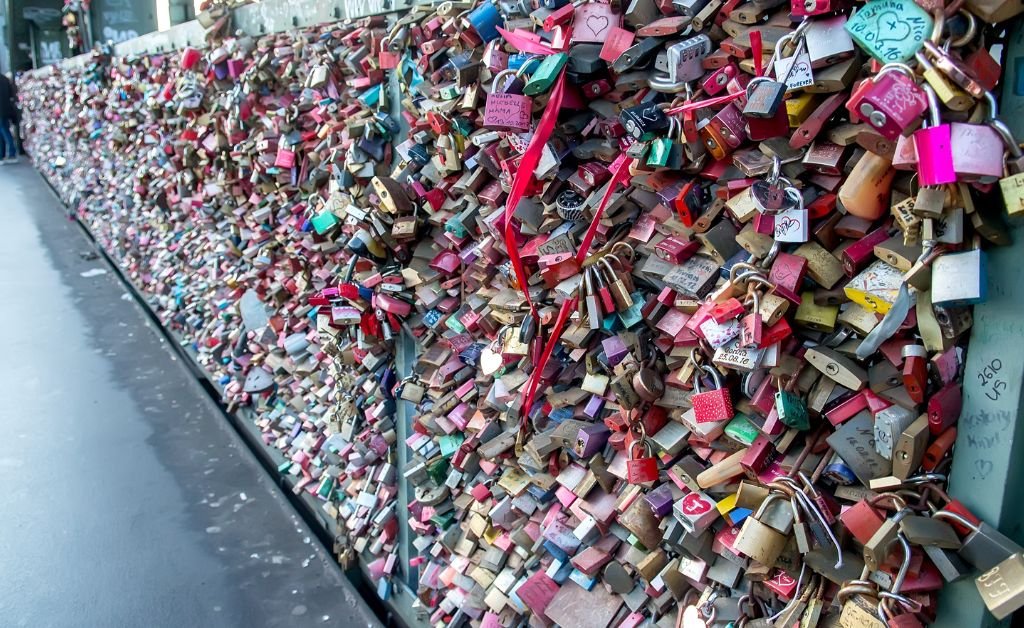Nestled in the heart of Paris, where the Seine River flows gently beneath, the Pont des Arts bridges not just two iconic landmarks—the Louvre and the Institut de France—but also countless hearts from across the globe. Known affectionately as the Love Lock Bridge Paris, this pedestrian crossing has become a symbol of romance, a canvas for declarations of love, and a pilgrimage site for couples and lovers.
While the tradition of attaching padlocks as tokens of love has ceased, the essence of what made the bridge a landmark of affection remains. The bridge’s fame was not just built on the metal of locks but on the stories they represented—each padlock a testament to love’s enduring power.
Today, the Pont des Arts offers breathtaking views, a sense of shared humanity, and a reminder of the simple, yet profound, ways in which people strive to connect and commit to one another. Stepping onto the bridge is like walking through the pages of a grand romantic narrative, set against the backdrop of one of the world’s most enchanting cities.
History of Love Lock Bridge Paris
The Love Lock Bridge in Paris, officially known as the Pont des Arts, holds a mesmerizing yet controversial place in the city’s romantic history. Spanning the Seine River, the bridge became an iconic symbol of love and commitment in the early 2000s. Couples worldwide began attaching padlocks, engraved with their names and sealed with their vows, to the bridge’s railing, then tossing the keys into the Seine below as a gesture of unbreakable love.
Inspired by a similar practice in Italy, this tradition quickly proliferated, covering the bridge with thousands of locks. However, the weight of these tokens of affection became a structural concern. In 2015, city officials removed the locks, citing safety risks and preservation of the historical site.
The Love Lock Bridge Paris remains a poignant testament to the enduring allure of Paris as the “City of Love,” capturing the hearts of both locals and visitors with its tale of romance, tradition, and the delicate balance between public expression and heritage conservation.
How Putting Love Locks on The Love Lock Bridge Started?
To the surprise of many, the phenomenon of attaching love locks to the Pont des Arts in Paris doesn’t stem from a long-standing tradition. In fact, up until recently, some officials were still debating whether it was merely a fleeting trend. The exact origins of how it began on the Pont des Arts are unclear, but the practice seemed to have made its way to Paris around 2008, possibly inspired by the Italian movie “Ho Voglia di Te” (“I Want You” in English).
The concept quickly gained popularity, and by 2015, it’s estimated that around 700,000 padlocks adorned the bridge, earning it the nickname “Love Lock Bridge.” While this gesture of locking one’s love was seen as romantic by many tourists, it posed significant concerns for Parisian authorities tasked with preserving the city’s heritage sites.
The cumulative weight of these locks was likened to having 20 elephants on the bridge — a scenario far beyond what the original engineers of the bridge would have ever considered, let alone the addition of a million padlocks equivalent to a whole herd of elephants.
Why Couple Visit The Love Lock Bridge?

Couples visit the Pont des Arts, often referred to as the Love Lock Bridge in Paris, for a variety of romantic and symbolic reasons, despite the removal of the love locks. This iconic bridge has become a symbol of love and romance around the world, drawing visitors for several key reasons:
The symbolism of Eternal Love
Originally, couples attached padlocks with their names or initials to the bridge’s railings and threw the keys into the Seine River as a gesture symbolizing unbreakable love and commitment. Even though this practice is no longer allowed, the bridge still represents the romantic gesture and attracts couples wanting to experience the aura of love that pervades the location.
Romantic Setting
The Pont des Arts offers a stunning backdrop for romance, with panoramic views of the Seine River, the Eiffel Tower, Notre Dame, and other Parisian landmarks. Its location in the heart of Paris makes it an ideal spot for couples to enjoy a romantic moment, especially at sunset or sunrise.
Cultural and Historical Significance
The bridge itself is a piece of Parisian history and culture, connecting the Institut de France with the Louvre. Its historical significance and the artistic atmosphere, being a popular spot for painters, artists, and photographers, add to the allure for couples looking for a deeper cultural experience.
Participation in a Global Phenomenon
Visiting the bridge allows couples to feel connected to a global tradition of celebrating love. Even without adding a lock, the act of visiting and perhaps taking a moment to reflect on their relationship ties them to the countless others who have shared similar moments.
Photographic Memories
The picturesque setting of the Pont des Arts makes it a perfect location for couples to capture photographs of their visit to Paris. The bridge serves as a beautiful reminder of their time spent in the city of love.
Alternative Celebrations of Love
Following the ban on love locks, couples have found other ways to commemorate their love while visiting the bridge, such as taking selfies, attaching virtual locks through apps, or simply enjoying the tradition’s legacy by being present.
In essence, couples are drawn to the Love Lock Bridge for its romantic allure, its significance as a symbol of love, and the opportunity to be part of a tradition that, despite its physical end, continues to live on in the hearts of those who visit.
Why Love Locks Removed From Bridge in Paris?
The love locks were removed from the Pont des Arts bridge in Paris due to structural safety concerns and the preservation of the city’s heritage. Over time, the tradition of attaching padlocks, symbolizing unbreakable love, resulted in over 700,000 locks hanging from the bridge, collectively weighing approximately 45 tonnes—the equivalent of 20 elephants. This immense weight posed a significant risk to the integrity of the bridge, which was not designed to carry such an additional load.
In 2014, part of the railing on the Pont des Arts even collapsed under the weight of the locks, highlighting the urgent need for action to prevent potential injury to pedestrians and damage to the bridge. In response to these concerns, the Paris city authorities initiated the “Love without Locks” campaign, encouraging visitors to find alternative ways to express their love without compromising the safety and aesthetic of the city’s structures.
Ultimately, in June 2015, the city took decisive action by removing the grilles with the locks attached and replacing them with glass panels. This measure was taken not only to ensure the safety of the bridge but also to protect the architectural and historical significance of Paris’s urban landscape, preventing similar issues from arising in the future.
The End of The Love Lock Bridge in Paris

In 2014, the sheer volume of love locks proved too much for the Pont des Arts in Paris, as the bridge nearly gave way under the immense weight. The railings, burdened with over 700,000 padlocks amounting to 45 tonnes (comparable to the weight of 20 elephants), could no longer bear the load. With an additional 7,500 locks expected to be added each year, urgent measures were necessary to ensure the safety of the public and preserve the integrity of this historic bridge.
Responding to this crisis, the Mayor’s Office of Paris initiated the “Love without Locks” campaign in August 2014, aiming to persuade visitors to express their affection in ways other than attaching padlocks to the bridge. Despite efforts to promote alternatives like picnics or taking selfies, the tradition of affixing love locks persisted unabated.
Left with no viable alternatives, the City of Paris was compelled to remove the locks to protect the bridge. On June 1, 2015, the railings laden with locks were taken down and eventually replaced with glass panels, ensuring that the bridge would be safeguarded against similar issues in the future.
How to Visit Love Lock Bridge Paris?
Visiting the Pont des Arts, famously known as the Love Lock Bridge, in Paris is a straightforward and memorable experience. Although the original love locks were removed to preserve the bridge’s structural integrity, the bridge itself remains a popular and romantic spot, offering breathtaking views of the Seine River and iconic Parisian landmarks. Here’s how to plan your visit:
Location
The Pont des Arts spans the Seine River, connecting the Institut de France and the central square (cour carrée) of the Palais du Louvre. This pedestrian bridge is easily accessible from both banks of the river.
Getting There
- By Metro: The nearest Metro stations are Louvre-Rivoli (Line 1) and Pont Neuf (Line 7). Both stations are a short walk away from the bridge.
- By RER: The Saint-Michel Notre-Dame station (RER B and C lines) is also nearby, offering a pleasant walk to the bridge along the Seine.
- On Foot: Walking is perhaps the best way to explore Paris. If you’re in the vicinity of the Louvre or the Latin Quarter, a stroll to the Pont des Arts offers scenic views and takes you through some charming areas of Paris.
Best Time to Visit
- Sunset: Visiting the bridge at sunset offers a magical backdrop for photos and a romantic ambiance, with the sky and the Seine taking on golden hues.
- Early Morning: For a more peaceful experience, early morning visits allow you to enjoy the bridge and its views with fewer people around.
Tips for Your Visit Love Lock Bridge
- Respect the Site: Remember that attaching locks to the bridge is no longer permitted. Instead, enjoy the beauty and history of the location without contributing to the harm of the structure.
- Photography: The Pont des Arts is a fantastic spot for photography, with the Louvre, the Institut de France, and the Seine providing excellent subjects for your pictures.
- Nearby Attractions: Combine your visit to the Pont des Arts with other nearby attractions such as the Louvre Museum, the Institut de France, or a stroll along the Seine’s banks.
Conclusion
The Pont des Arts, once adorned with countless symbols of love in the form of padlocks, stands today as a poignant reminder of Paris’s enduring allure as the city of romance. Although the physical locks have been removed to preserve the structural integrity of this historic bridge, the essence of the Love Lock Bridge remains undiminished.
It continues to be a testament to the timeless nature of love, attracting couples and visitors from around the world who seek to experience its romantic legacy. As they walk across, visitors are enveloped in the bridge’s unique atmosphere, surrounded by the breathtaking beauty of the Seine and the iconic Parisian skyline. The Pont des Arts transcends its original purpose, evolving into a symbol of love’s resilience and the collective memory of thousands of shared moments.
In the heart of Paris, the bridge serves as a beautiful reminder that while expressions of love may change, the feelings that inspire them remain as strong and as vital as ever. In this way, the Love Lock Bridge continues to capture the imagination and hearts of all who visit, embodying the spirit of love in the city that has always been its most famous champion.















